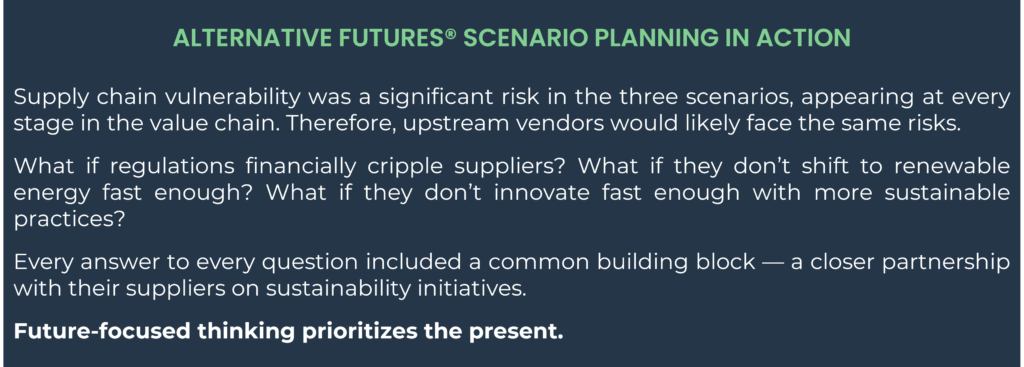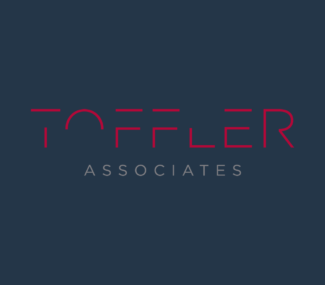TCFD Report Becomes a Fortune 100 Company’s 10-year Plan

The VP of Sustainability of a Fortune 100 enterprise had overseen the company’s giant climate change strides in 2021. The company created baseline measurements and goals for CO2e (carbon dioxide-equivalent) emissions reduction commitments and the company grew by double digits, increasing value for stakeholders while reducing its carbon footprint. As 2022 began, however, the company realized that producing more while emitting less wasn’t enough. Customers demanded faster change, and activist investors were insisting that climate actions be made public.
New sustainability requirements were coming soon
While reporting on climate action was still voluntary for US-based public companies, SEC climate reporting rules were on the horizon. Dozens of boards urged company ESG teams to satisfy ever-increasing global regulatory requirements and report progress through the Financial Stability Board’s Task Force on Climate-related Financial Disclosures (TCFD) framework. Companies were compelled to get ahead of these requirements.
The VP of Sustainability faced two immediate challenges
- The sustainability team needed to deliver on deeper climate reporting and action plans.
- The company needed to achieve the next level of progress on sustainability goals.
Both would require a step-change increase in organizational commitment.
Creating a TCFD reporting plan would address sustainability challenges
While several organizations (GHG, SBTi, SASB) had developed sustainability reporting frameworks over the years, the TCFD reporting framework was emerging as the standard. The framework helps investors by ensuring that public companies are more rigorous and consistent in their climate-related financial disclosures:
- Risk assessment – Evaluating climate-related risks to the company, its suppliers, and competitors.
- Capital allocation – Making better-informed decisions on where and when to allocate your capital.
- Strategic planning – Evaluating and mitigating risks and exposures over the short, medium, and long term.
And it solved the Sustainability VP’s two overarching needs: Achieving next-level progress on company sustainability goals and responding to investor pressures.
TCFD reporting has many guidelines but no simple template
The TCFD website has hundreds of pages of guidance. There were no templates, but over 130 sample TCFD reports from over 100 companies, none of which were in the same industry. The scenario analysis process outlined on the website includes five TCFD workshops — TCFD Fundamentals, Governance, Strategy, Risk Management, and Metrics and Targets. Each came with a 40-page “how-to” deck.
They lacked the broad scenario planning experience needed for TCFD reporting
The sustainability leader quickly learned that TCFD wasn’t a simple checklist. Climate scenario analysis, the essential output of TCFD reporting, is a complex undertaking that required processes and capabilities the company didn’t have in-house. The ESG leader needed experienced experts.
They selected Toffler Associates to drive the TCFD reporting process
The VP needed TCFD consultants with expertise in running scenario planning processes, as well as climate scenario analysis experience. Research led to Toffler Associates, a consulting firm that has integrated futures and foresight into its scenario analysis for over 25 years. Toffler Associates worked with the VP of Sustainability to develop scenarios tailored to the company’s unique operational environment that would get beyond temperature change impacts. Having completed dozens of Alternate Futures® projects, the Toffler team created a customized playbook for the Fortune 100 company.
| Spotlight on Alternative Futures® Scenario Planning
Alternate Futures® is a future-focused methodology that identifies drivers of change that create a range of possible futures. Stakeholders test the outcomes of decisions in multiple alternate futures and potential scenarios within them. The idea is to “stand in the future” and safely test and experience the opportunities, risks, and consequences of various courses of action. Experienced alternative futures consultants would be ideal for helping drive the process and outcomes. |
![]()
Toffler Associates facilitated climate scenario analysis workshops
The initial workshop aimed to help the company’s executives understand how potential climate scenarios could present challenges and opportunities. Next, each would identify ways to prepare the organization to respond to climate change.
The TCFD framework included three climate change scenarios to analyze
They organized the workshops into three working groups, and each focused on reacting to different climate change scenarios. Going beyond simply temperature change, each climate change scenario considered the second- and third-order impacts through the eyes of seven stakeholders — customers, shareholders, employees, communities, operations, suppliers, and regulators.
- 1.5 ° – 2.5° warming by 2100 — aided by proactive global regulatory approaches.
- 2.5 ° – 3.0° — due to more fragmented governmental, commercial, and consumer approaches.
- 3.0°+ — due to the world’s reactive approach to climate change’s impacts.
The next step would be gaining executive stakeholders’ participation to generate actionable recommendations.
Their TCFD framework and plan required executive participation*
What do an EVP of Logistics, Country Managers for Spain and Japan, an SVP of Marketing, a CEO, and a COO have in common?
For this Fortune 100 company, each was one of fifty people required to staff eight working groups. More than thirty would pull double duty, participating in two groups. In total, the working team would include:
- 4 C-level executives, 5 EVPs, and 25 SVPs from 4 continents
- Functional leaders, including Country GMs, Construction, Purchasing, Logistics, Finance & Accounting, Technology, Marketing, Real Estate, Operations, Business Development, Administration, Treasury, Investor Relations, Product, and Data & Analytics
![]()
*Representative of the level/scale of organizational involvement but without actual titles
The VP had anticipated questions:
- “I’m the Country Manager for South Korea. What do I have to do with Climate Scenario Analysis?”
- “I’m the CIO. How will I contribute to Climate Scenario Analysis?”
- “I’m the SVP of Treasury. What is the TCFD Framework, and what do I have to do with it?”
However, the VP understood the strategic potential these sessions could unlock. They needed insights from executives across many roles and geographies:
- First, perspectives across the entire business were important inputs.
- Second, by including those who would execute recommendations, buy-in and faster results were more likely.
Soon they got started, with the team’s TCFD recommendations close behind. Before long, what began as a “checklist exercise” became a long-term strategic planning initiative.
Eight working groups and workshops generated 28 TCFD recommendations.
Initial workshops aimed to help the company’s executives better understand how potential climate scenarios could present challenges and opportunities for their business. The follow-on mission was to identify ways to prepare the organization to respond to climate change.
They explored three possible future scenarios, and the executive team identified five top implications requiring action for each.
The TCFD recommendation process began by identifying the drivers of each climate scenario
Teams considered what had to occur for global temperatures to increase only 1.5 to 2.5℃ by 2100. They also considered what would be different if climate change was more than 3.0℃.
- How will governments react in each scenario?
- What technologies would be needed to achieve different climate change goals?
- Will the public’s “willingness to pay” keep pace with necessary innovations and regulatory compliance?
For example, slower climate change would require close global government collaboration, stringent sustainability requirements, new measurement techniques, and more. What limits and regulations would have to be in place? What do we need to do today to be ready for those regulations?
Meanwhile, if temperatures increase by 3℃ or more, it will imply that global governments did not collaborate and rules were fragmented. It would mean that consumers were likely unwilling to shoulder the sustainability effort costs. A 3℃ increase would affect sea levels – which facilities will be affected, and how can we prepare today?
Determining the implications and TCFD recommendations for stakeholders
With fifty executives involved, the broad team considered dozens of consequences for customers, shareholders, employees, communities, operations, suppliers, and regulators.![]()
People were the essential stakeholders in the company’s climate scenarios:
- Tens of millions of end customers – how will their needs change, and how will we remain their top brand?
- Hundreds of thousands of employees – how can we mobilize them in sustainability efforts?
- Hundreds of local communities – how can we help our communities achieve sustainability goals?
- Activist investors – what additional requirements are likely, and how can we prepare today?
The team also considered operations and financial results.
- How must we transform our physical locations and operations to reduce emissions?
- What are the risks and opportunities of being a first mover in technology?
Some fascinating questions emerged:
- How will customer buying habits change in each scenario?
- How will the impact of regulatory disruption affect product scarcity?
- What will the impacts on operational efficiency be, and what can we do about them?
The team discussed complex concepts, such as the interactions between climate change estimates, the expected regulation level in each scenario, and the ensuing supply chain disruptions, plus numerous additional factors.

They also learned that TCFD Recommendations are not all gloom & doom
The TCFD framework helped the executive team uncover near-term topline and bottom-line growth opportunities. The executive team realized that, even though climate impacts may occur years into the future, they could make decisions and changes today to be prepared for—and even positively impact—climate change.
Their second big “aha” was that these workshops about 2030 could help the company grow faster in 2023.
For instance, the company could save hard cash by upping its recycling game and involving its suppliers. They even discussed vertical integration and potential acquisitions to reduce supply chain risks.
Scenario analysis also highlighted the importance of climate change partnerships with suppliers.
Ultimately, they aligned on the five most urgent implications for the three climate change scenarios.
TCFD Recommendations transformed into strategic imperatives
Future-focused planning proved to be a game-changer. By looking backward from 2030, the TCFD climate scenario analysis team identified clear-cut initiatives to begin now. The process clarified how important many of these recommendations would be for the company’s future.
The project developed a company-wide, integrated roadmap with clear initiatives. Executive owners throughout the company started launching these projects immediately. The team generated 28 discreet initiatives to kick off in 2022 and 2023, with roadmaps running as far as 2030.
Sustainability is now a key pillar in the company’s strategy
Gone are the days when sustainability was considered a regulatory compliance requirement. Going forward, the board and the C-suite viewed the ESG team’s work as central to the company’s strategic planning. The VP of Sustainability had the full force of the company behind them in meeting ESG objectives. After all, the changes the company can make aren’t only good for the climate. They’re good for business.


 About the Authors
About the Authors